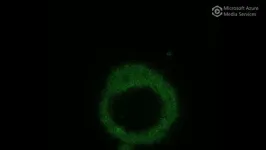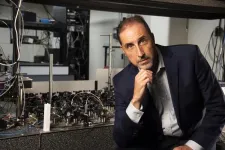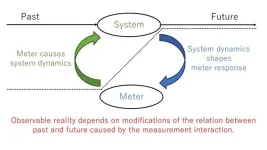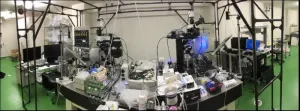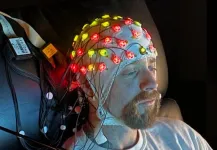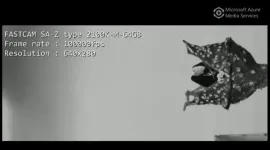(Press-News.org) It’s notoriously difficult for doctors to identify a wound that is becoming infected. Clinical signs and symptoms are imprecise and methods of identifying bacteria can be time-consuming and inaccessible, so a diagnosis can be subjective and dependent on clinician experience. But infection can stall healing or spread into the body if it isn’t treated quickly, putting a patient’s health in grave danger. An international team of scientists and clinicians thinks they have the solution: a device run from a smartphone or tablet app which allows advanced imaging of a wound to identify infection.
“Wound care is one of today’s most expensive and overlooked threats to patients and our overall healthcare system,” said Robert Fraser of Western University and Swift Medical Inc, corresponding author of the study published in Frontiers in Medicine. “Clinicians need better tools and data to best serve their patients who are unnecessarily suffering.”
Shedding light on injuries
The scientists developed a device called the Swift Ray 1 which can be attached to a smartphone and connected to the Swift Skin and Wound software. This can take medical-grade photographs, infrared thermography images (which measure body heat), and bacterial fluorescence images (which reveal bacteria using violet light).
None of these images would be enough to identify infection alone. Clinical inspection has low accuracy, as does thermography measuring heat changes caused by inflammation and infection. Bacterial fluorescence can only look at the surface of a wound, which is naturally contaminated with bacteria, so additional methods are needed to differentiate between contamination and an infected wound.
“Research has demonstrated bacterial imaging helps guide clinicians’ work to remove nonviable tissue, yet it cannot identify infection by itself,” explained Dr Jose Ramirez-GarciaLuna of McGill University Health Centre, first author of the study. “Thermography provides insight into the inflammatory and circulatory changes happening under the skin.”
The scientists sought to combine these modalities to come up with a method which wouldn’t need multiple expensive devices, would overcome the weaknesses of each imaging method, and could provide an objective measure of wound healing.
To test their device, they recruited 66 wounded patients. Their wounds showed no sign of infection spreading further, did not contain foreign bodies, and had not previously been treated with antibiotics or growth factors. The patients’ wounds were uncovered, cleaned, and dried before imaging, and afterwards cared for as usual.
A picture of health
The images were reviewed by a researcher who wasn’t present for the wound care process. Four patterns were identified.
Wounds where the wound was not warmer than healthy skin and no bacterial fluorescence was present were considered ‘non-inflamed’, while wounds that were slightly warmer than healthy skin and had no or slight bacterial fluorescence were considered ‘inflamed’. The last two patterns — wounds that were substantially warmer, with or without bacterial fluorescence — were both designated as ‘infected’, because all the clinicians who had examined these wounds had considered them infected.
Out of the 66 wounds, 20 were considered non-inflamed, 26 were inflamed, and 20 were infected.
The researchers performed principal component analysis and used an algorithm called nearest k-neighbor clustering to see if a machine learning model could accurately identify these different categories of wound. They found that the model could identify all three very well, with an overall accuracy of 74%. When differentiating between infected vs. non-infected wounds, the model correctly identified 100% of infected wounds and 91% of non-infected wounds.
A new tool in the box
The researchers pointed out that the images should always be considered in their medical context. For instance, a wound that is cool enough to be categorized as non-inflamed could have a limited blood supply, compromising healing. But because the Swift Ray 1 combined with the Swift Skin and Wound software allows doctors to combine multiple modalities of identifying infection, it increases the tools available to them without demanding the use of several expensive devices. In the future it could make it possible to secure a rapid, accurate diagnosis for every wounded patient and enable more effective telemedicine assessments.
“This was a pilot study and follow up studies are planned,” cautioned Fraser. “In the future, patient populations with more wound types are required to validate across populations.”
END
New pocket-sized device for clinicians could spot infected wounds faster
An app-controlled device which uses heat signatures and bacterial fluorescence to identify infected wounds could help doctors and nurses catch and treat infections faster
2023-08-24
ELSE PRESS RELEASES FROM THIS DATE:
Speech Accessibility Project recruiting people with Parkinson’s
2023-08-24
Urbana, Illinois — The Speech Accessibility Project is almost halfway through its first phase of gathering voice recordings from people with Parkinson’s.
The project still needs more participants, especially those with related neurological conditions like MSA, PSP, CBD, and those who are post-DBS. They must be U.S. residents older than age 18. They can sign up via the Speech Accessibility App.
Led by UIUC with support from Amazon, Apple, Google, Meta, and Microsoft, the Speech Accessibility Project aims to make voice recognition technology ...
When proteins get stuck at solid: unlocking the secrets to brain diseases
2023-08-24
Many diseases affecting the brain and nervous system are linked to the formation of protein aggregates, or solid condensates, in cells from their liquid form condensate, but little is known about this process.
This liquid-to-solid transition can trigger the formation of what are called amyloid fibrils. These can further form plaques in neurons causing neurodegenerative diseases such as Alzheimer's.
Biomedical engineers at the University of Sydney, in collaboration with scientists at the University of Cambridge ...
NPS professor’s DURIP award will take quantum research to new heights
2023-08-24
Naval Postgraduate School (NPS) Professor Dr. Frank Narducci, Chair of the Department of Physics, received a Defense University Research Instrumentation Program (DURIP) award to build what could become the most precise atomic instrument of its kind for applications to quantum sensing experiments in navigation and timekeeping.
Called an atomic tower, the instrument is expected to have unprecedented sensitivity to acceleration and rotation measurements due to its unprecedented height. NPS research utilizing this instrument has many applications of interest to the Department of the Navy, Narducci explained.
“Most immediately ...
Griffith on the cusp of a new vaccine modality breakthrough
2023-08-24
Griffith University researchers are on the brink of a technological breakthrough in vaccine development with a possible new vaccine modality.
Professor Bernd Rehm and Dr Shuxiong Chen from the Griffith Institute for Drug Discovery (GRIDD) and Griffith’s Centre for Cell Factories and Biopolymers have succeeded in developing a new vaccine modality that is a stable particulate vaccine.
The new vaccine modality is at proof-of-concept stage and in early development.
To demonstrate this vaccine approach, it was tested with a more established Griffith vaccine against Strep A that is currently performing strongly in human clinical trials in Canada.
Professor ...
Do measurements produce the reality they show us?
2023-08-24
Whenever the precision of a measurement approaches the uncertainty limit defined by quantum mechanics, the outcomes of the measurement depend on the dynamics of the interactions with the meter used to determine a physical property of the system. This finding may explain why quantum experiments often produce conflicting results and may contradict basic assumptions regarding physical reality.
Two quantum physicists from Hiroshima University recently analyzed the dynamics of a measurement interaction, where the value of a physical property is identified with a quantitative change in the meter state. This is a difficult problem, because quantum theory does not identify the value ...
The mouse metaverse: A tool for understanding the molecular mechanism of autism and the mind
2023-08-24
Autism is difficult to study and more difficult to treat because it is an individual condition lacking precise quantification. The development of mouse models of human mental disorders has proven a tractable approach to studying the molecular mechanisms, a new review argues and highlights the current state of the art in autism research.
Whether or not the autism spectrum is a disorder to be treated or a disability to be accommodated is debated by experts. This, however, is symptomatic for the fact that it is a very individual condition that has many expressions as well as causes, with no quantitative evaluation system or objective, mechanized diagnostic method. This makes ...
New ‘verbal treasure trove’ dictionary captures nuances and uses of Shakespeare’s words
2023-08-24
William Shakespeare used the word dotage to capture reduced mental ability (as in being blindly in love) rather than as a quaint term for old age, successes were really outcomes – one could talk of a ‘bad success’ – and, it turns out, the word bastard back then most often referred to a flower that was genetically hybrid.
A new dictionary, a verbal treasure trove of the nuances and uses of Shakespeare’s words, is published this week.
While dinner was preferred by Shakespeare for what we might think of as lunch (although his contemporaries used it to refer to an evening meal), beef, as today, was strongly associated with the English, but particularly the lower ...
Breast cancer study altered guidelines in Sweden
2023-08-24
BRCA1 and BRCA2 are well-known breast cancer genes associated with a significantly increased risk of hereditary breast and ovarian cancer. However, there are an additional eleven genes associated with elevated risk for these types of cancer. A multi-year Swedish study now reveals that the proportion of women with genetically confirmed hereditary breast cancer doubled by including all genes in the screening test.
In a Swedish research study including patients between 2012 and 2018, all cancer genetic clinics in Sweden participated. A total of 4759 individuals underwent comprehensive ...
Researchers to probe brain mechanisms behind free will
2023-08-24
Picture this scenario: You and a friend are walking around your neighborhood when you stop at a crosswalk. As you wait, the noises of the world and your internal thoughts all vie for your attention. Suddenly, you see a motorist nearly hit a bicyclist.
“Whoa, did you see that?” you say to your friend.
“I sure did; that was a fully restored 1967 Ford Mustang,” your friend replies, referring to a car separate from the near-traffic collision.
Despite being in the same place at the same time, and looking at the same scene, you and your friend paid attention to different things.
Why? ...
Blink and you'll miss these plants shooting their seeds
2023-08-24
DURHAM, N.C. -- If you happened upon a witch hazel plant in the forest, you might describe it as a sweet-smelling shrub with crinkly ribbon-like petals. But to Duke University graduate student Justin Jorge, it’s a howitzer.
That’s because of the impressive firepower of its fruits.
When witch hazels are ready to disperse their seeds, their woody seed capsules split open. Pressure builds up, and eventually the seeds shoot out like bullets fired from a rifle, hitting 30 feet per second in about half a millisecond.
“If you blink you’ll miss it,” said Jorge, who worked on this project as part of his Ph.D. thesis in biomechanics with senior author ...
LAST 30 PRESS RELEASES:
A new way to map how cells choose their fate
Numbers in our sights affect how we perceive space
SIMJ announces global collaborative book project in commemoration of its 75th anniversary
Air pollution exposure and birth weight
Obstructive sleep apnea risk and mental health conditions among older adults
How talking slows eye movements behind the wheel
The Ceramic Society of Japan’s Oxoate Ceramics Research Association launches new international book project
Heart-brain connection: international study reveals the role of the vagus nerve in keeping the heart young
Researchers identify Rb1 as a predictive biomarker for a new therapeutic strategy in some breast cancers
Survey reveals ethical gaps slowing AI adoption in pediatric surgery
Stimulant ADHD medications work differently than thought
AI overestimates how smart people are, according to HSE economists
HSE researchers create genome-wide map of quadruplexes
Scientists boost cell "powerhouses" to burn more calories
Automatic label checking: The missing step in making reliable medical AI
Low daily alcohol intake linked to 50% heightened mouth cancer risk in India
American Meteorological Society announces Rick Spinrad as 2026 President-Elect
Biomass-based carbon capture spotlighted in newly released global climate webinar recording
Illuminating invisible nano pollutants: advanced bioimaging tracks the full journey of emerging nanoscale contaminants in living systems
How does age affect recovery from spinal cord injury?
Novel AI tool offers prognosis for patients with head and neck cancer
Fathers’ microplastic exposure tied to their children’s metabolic problems
Research validates laboratory model for studying high-grade serous ovarian cancer
SIR 2026 delivers transformative breakthroughs in minimally invasive medicine to improve patient care
Stem Cell Reports most downloaded papers of 2025 highlight the breadth and impact of stem cell research
Oxford-led study estimates NHS spends around 3% of its primary and secondary care budget on the health impacts of heat and cold in England
A researcher’s long quest leads to a smart composite breakthrough
Urban wild bees act as “microbial sensors” of city health.
New study finds where you live affects recovery after a hip fracture
Forecasting the impact of fully automated vehicle adoption on US road traffic injuries
[Press-News.org] New pocket-sized device for clinicians could spot infected wounds fasterAn app-controlled device which uses heat signatures and bacterial fluorescence to identify infected wounds could help doctors and nurses catch and treat infections faster

